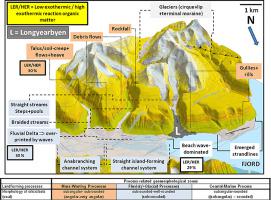当前位置:
X-MOL 学术
›
Int. J. Coal Geol.
›
论文详情
Our official English website, www.x-mol.net, welcomes your
feedback! (Note: you will need to create a separate account there.)
Organic debris and allochthonous coal in Quaternary landforms within a periglacial setting (Longyearbyen Mining District, Norway) - A multi-disciplinary study (coal geology-geomorphology-sedimentology)
International Journal of Coal Geology ( IF 5.6 ) Pub Date : 2021-01-01 , DOI: 10.1016/j.coal.2020.103625 Harald G. Dill , Kus Jolanta , Buzatu Andrei , Balaban Sorin-Ionut , Kaufhold Stephan , Angeles G. Borrego
International Journal of Coal Geology ( IF 5.6 ) Pub Date : 2021-01-01 , DOI: 10.1016/j.coal.2020.103625 Harald G. Dill , Kus Jolanta , Buzatu Andrei , Balaban Sorin-Ionut , Kaufhold Stephan , Angeles G. Borrego

|
Abstract High volatile bituminous coal C and B is currently exploited at Spitsbergen-Svalbard, Norway. Several coal seams formed during the Palaeocene, of which some were reworked by mass wasting (MW), (glacial)-fluvial (GF) and coastal-marine wave-dominated (WM) processes under periglacial conditions during the Quaternary. This supergene alteration resulted in different landforms and deposit bearing four different types of depositional environments in Svalbard: (1) Invisible floral and faunal remains, (2) visible floral remains, (3) drift wood, (4) coal placers s. The subaerial slow- and fast-moving MW was accompanied by chemical weathering giving rise to jarosite coatings indicative of acidic meteoric solutions, whereas the remaining subaquatic processes operated under neutral to slightly alkaline conditions. Fast-moving MW and WM are productive processes, whereas GF ones are destructive with regard to coal accumulation. The most efficient tools to study the origin of the OM-bearing coarse-grained deposits are the morphology and orientation of bioclasts while the LER/HER (= low exothermic / high exothermic reaction) ratio is used for finer-grained OM-bearing sediments. The maceral analysis revealed that the landforms accounted for by GF and WM were emplaced as a result of geogenic and anthropogenic processes and aged younger than 1900 CE, while MW is Quaternary and true geogenic. Driftwood is cast in the role of a marker for coal-bearing (fluvial-) marine environments different in age and rank of coalification. With this in mind it is an excellent tool to drawn the boundary in paralic settings between the marine and fluvial impact. In conclusion, coal fragments are markers for short-term, periodical and fast landform-building processes, whereas siliciclasts from the host and bedrock are markers for long-term and episodical geomorphological and sedimentological supergene alteration.
中文翻译:

冰缘环境中第四纪地貌中的有机碎片和外来煤(挪威朗伊尔城矿区)——一项多学科研究(煤地质学-地貌学-沉积学)
摘要 目前,挪威的斯匹次卑尔根-斯瓦尔巴群岛正在开采高挥发性烟煤 C 和 B。在古新世期间形成了几个煤层,其中一些煤层在第四纪冰缘条件下通过质量浪费(MW)、(冰川)-河流(GF)和沿海-海洋波浪主导(WM)过程重新加工。这种表生改变导致斯瓦尔巴群岛具有四种不同类型的沉积环境的不同地貌和沉积物:(1)看不见的花卉和动物遗存,(2)可见的花卉遗存,(3)漂流木,(4)煤砂。水下缓慢和快速移动的 MW 伴随着化学风化,产生了表明酸性大气溶液的黄钾铁矾涂层,而其余的水下过程在中性至微碱性条件下运行。快速移动的 MW 和 WM 是生产过程,而 GF 对煤炭积累具有破坏性。研究含 OM 粗粒沉积物起源的最有效工具是生物碎屑的形态和方向,而 LER/HER(= 低放热/高放热反应)比用于细粒含 OM 沉积物。宏观分析表明,GF 和 WM 占位的地貌是地质和人为过程的结果,年龄小于 1900 CE,而 MW 是第四纪和真正的地质成因。漂流木扮演着不同年龄和煤化等级的含煤(河流)海洋环境的标志的角色。考虑到这一点,它是在海洋和河流影响之间的近海环境中划定边界的绝佳工具。综上所述,
更新日期:2021-01-01
中文翻译:

冰缘环境中第四纪地貌中的有机碎片和外来煤(挪威朗伊尔城矿区)——一项多学科研究(煤地质学-地貌学-沉积学)
摘要 目前,挪威的斯匹次卑尔根-斯瓦尔巴群岛正在开采高挥发性烟煤 C 和 B。在古新世期间形成了几个煤层,其中一些煤层在第四纪冰缘条件下通过质量浪费(MW)、(冰川)-河流(GF)和沿海-海洋波浪主导(WM)过程重新加工。这种表生改变导致斯瓦尔巴群岛具有四种不同类型的沉积环境的不同地貌和沉积物:(1)看不见的花卉和动物遗存,(2)可见的花卉遗存,(3)漂流木,(4)煤砂。水下缓慢和快速移动的 MW 伴随着化学风化,产生了表明酸性大气溶液的黄钾铁矾涂层,而其余的水下过程在中性至微碱性条件下运行。快速移动的 MW 和 WM 是生产过程,而 GF 对煤炭积累具有破坏性。研究含 OM 粗粒沉积物起源的最有效工具是生物碎屑的形态和方向,而 LER/HER(= 低放热/高放热反应)比用于细粒含 OM 沉积物。宏观分析表明,GF 和 WM 占位的地貌是地质和人为过程的结果,年龄小于 1900 CE,而 MW 是第四纪和真正的地质成因。漂流木扮演着不同年龄和煤化等级的含煤(河流)海洋环境的标志的角色。考虑到这一点,它是在海洋和河流影响之间的近海环境中划定边界的绝佳工具。综上所述,











































 京公网安备 11010802027423号
京公网安备 11010802027423号